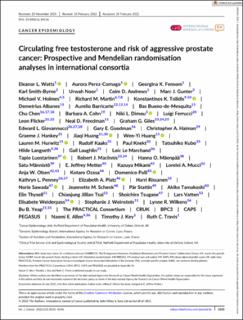Circulating free testosterone and risk of aggressive prostate cancer: Prospective and Mendelian randomisation analyses in international consortia
| dc.contributor.author | Watts, Eleanor L. | |
| dc.contributor.author | Perez-Cornago, Aurora | |
| dc.contributor.author | Fensom, Georgina K. | |
| dc.contributor.author | Smith-Byrne, Karl | |
| dc.contributor.author | Noor, Urwah | |
| dc.contributor.author | Andrews, Colm D. | |
| dc.contributor.author | Gunter, Marc J. | |
| dc.contributor.author | Holmes, Michael V. | |
| dc.contributor.author | Martin, Richard M. | |
| dc.contributor.author | Tsilidis, Konstantinos K. | |
| dc.contributor.author | Albanes, Demetrius | |
| dc.contributor.author | Barricarte, Aurelio | |
| dc.contributor.author | Bueno-de-Mesquita, Bas | |
| dc.contributor.author | Chen, Chu | |
| dc.contributor.author | Cohn, Barbara A. | |
| dc.contributor.author | Dimou, Niki L. | |
| dc.contributor.author | Ferrucci, Luigi | |
| dc.contributor.author | Flicker, Leon | |
| dc.contributor.author | Freedman, Neal D. | |
| dc.contributor.author | Giles, Graham G. | |
| dc.contributor.author | Giovannucci, Edward L. | |
| dc.contributor.author | Goodman, Gary E. | |
| dc.contributor.author | Haiman, Christopher A. | |
| dc.contributor.author | Hankey, Graeme J. | |
| dc.contributor.author | Huang, Jiaqi | |
| dc.contributor.author | Huang, Wen-Yi | |
| dc.contributor.author | Hurwitz, Lauren M. | |
| dc.contributor.author | Kaaks, Rudolf | |
| dc.contributor.author | Knekt, Paul | |
| dc.contributor.author | Kubo, Tatsuhiko | |
| dc.contributor.author | Langseth, Hilde | |
| dc.contributor.author | Laughlin, Gail | |
| dc.contributor.author | Le Marchand, Loic | |
| dc.contributor.author | Luostarinen, Tapio | |
| dc.contributor.author | MacInnis, Robert J. | |
| dc.contributor.author | Mäenpää, Hanna O. | |
| dc.contributor.author | Männistö, Satu | |
| dc.contributor.author | Metter, E. Jeffrey | |
| dc.contributor.author | Mikami, Kazuya | |
| dc.contributor.author | Mucci, Lorelei A. | |
| dc.contributor.author | Olsen, Anja | |
| dc.contributor.author | Ozasa, Kotaro | |
| dc.contributor.author | Palli, Domenico | |
| dc.contributor.author | Penney, Kathryn L. | |
| dc.contributor.author | Platz, Elizabeth A. | |
| dc.contributor.author | Rissanen, Harri | |
| dc.contributor.author | Sawada, Norie | |
| dc.contributor.author | Schenk, Jeannette M. | |
| dc.contributor.author | Stattin, Pär | |
| dc.contributor.author | Tamakoshi, Akiko | |
| dc.contributor.author | Thysell, Elin | |
| dc.contributor.author | Tsai, Chiaojung Jillian | |
| dc.contributor.author | Tsugane, Shoichiro | |
| dc.contributor.author | Vatten, Lars Johan | |
| dc.contributor.author | Weiderpass, Elisabete | |
| dc.contributor.author | Weinstein, Stephanie J. | |
| dc.contributor.author | Wilkens, Lynne R. | |
| dc.contributor.author | Yeap, Bu B. | |
| dc.contributor.author | Allen, Naomi E. | |
| dc.contributor.author | Key, Timothy J. | |
| dc.contributor.author | Travis, Ruth C. | |
| dc.date.accessioned | 2022-11-18T10:04:11Z | |
| dc.date.available | 2022-11-18T10:04:11Z | |
| dc.date.created | 2022-10-03T10:18:13Z | |
| dc.date.issued | 2022 | |
| dc.identifier.citation | International Journal of Cancer. 2022, 151 (7), 1033-1046. | en_US |
| dc.identifier.issn | 0020-7136 | |
| dc.identifier.uri | https://hdl.handle.net/11250/3032807 | |
| dc.description.abstract | Previous studies had limited power to assess the associations of testosterone with aggressive disease as a primary endpoint. Further, the association of genetically predicted testosterone with aggressive disease is not known. We investigated the associations of calculated free and measured total testosterone and sex hormone-binding globulin (SHBG) with aggressive, overall and early-onset prostate cancer. In blood-based analyses, odds ratios (OR) and 95% confidence intervals (CI) for prostate cancer were estimated using conditional logistic regression from prospective analysis of biomarker concentrations in the Endogenous Hormones, Nutritional Biomarkers and Prostate Cancer Collaborative Group (up to 25 studies, 14 944 cases and 36 752 controls, including 1870 aggressive prostate cancers). In Mendelian randomisation (MR) analyses, using instruments identified using UK Biobank (up to 194 453 men) and outcome data from PRACTICAL (up to 79 148 cases and 61 106 controls, including 15 167 aggressive cancers), ORs were estimated using the inverse-variance weighted method. Free testosterone was associated with aggressive disease in MR analyses (OR per 1 SD = 1.23, 95% CI = 1.08-1.40). In blood-based analyses there was no association with aggressive disease overall, but there was heterogeneity by age at blood collection (OR for men aged <60 years 1.14, CI = 1.02-1.28; Phet = .0003: inverse association for older ages). Associations for free testosterone were positive for overall prostate cancer (MR: 1.20, 1.08-1.34; blood-based: 1.03, 1.01-1.05) and early-onset prostate cancer (MR: 1.37, 1.09-1.73; blood-based: 1.08, 0.98-1.19). SHBG and total testosterone were inversely associated with overall prostate cancer in blood-based analyses, with null associations in MR analysis. Our results support free testosterone, rather than total testosterone, in the development of prostate cancer, including aggressive subgroups. | en_US |
| dc.language.iso | eng | en_US |
| dc.publisher | Wiley | en_US |
| dc.rights | Navngivelse 4.0 Internasjonal | * |
| dc.rights.uri | http://creativecommons.org/licenses/by/4.0/deed.no | * |
| dc.title | Circulating free testosterone and risk of aggressive prostate cancer: Prospective and Mendelian randomisation analyses in international consortia | en_US |
| dc.title.alternative | Circulating free testosterone and risk of aggressive prostate cancer: Prospective and Mendelian randomisation analyses in international consortia | en_US |
| dc.type | Peer reviewed | en_US |
| dc.type | Journal article | en_US |
| dc.description.version | publishedVersion | en_US |
| dc.source.pagenumber | 1033-1046 | en_US |
| dc.source.volume | 151 | en_US |
| dc.source.journal | International Journal of Cancer | en_US |
| dc.source.issue | 7 | en_US |
| dc.identifier.doi | 10.1002/ijc.34116 | |
| dc.identifier.cristin | 2057687 | |
| cristin.ispublished | true | |
| cristin.fulltext | original | |
| cristin.qualitycode | 2 |

